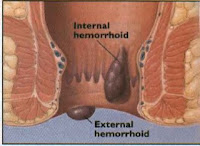Hemorrhoid is a widening of the veins in the plexus hemorroidalis is not a pathological condition. Hemorrhoid is the swelling in the anal canal submucosal venous plexus containing, small arteries, and areola tissue, which widened.
Hemorrhoid can be experienced by anyone. But often people feel embarrassed or considered not important, less attention to these health problems. In anatomy hemorrhoid is not a disease but a physiological changes that occur in blood vessels in the rectal pads, such as dilation and swelling of blood vessels and surrounding tissue.
Bearing functions as a valve / valve that helps anal muscles hold stool. If there is interference (dam) blood flow, the blood vessels will dilate and swell, a condition called hemorrhoids.
Signs and Symptoms
- Rectal bleeding, blood coming out can be a trickle but can also flowing, pink blood, patients usually do not feel sick.
- Taste prop, after defecation, no sensation of lump, this condition creates the impression that the process of defecation is not over, so someone pushing stronger, this action makes the hemorrhoid getting worse.
- Itching, because the part that feels pain in the anus is difficult to clean, the virus is very easy to cause skin infections that trigger itching.
In general, divided into two piles internal hemorrhoid and external hemorrhoid.
4 Nursing Diagnosis for Hemorrhoids
1. Ineffective breathing pattern related to decreased pressure inspiration - expiration for anesthetic agent administration.
2. Fluid volume and electrolyte deficit related to lack of or loss of fluid volume during surgery.
3. Risk for injury related to the effects of anesthesia and weakness.
4. Risk for Hypothermia related to multiple factors of age, body weight, factors trauma, neuromuscular and environment.

